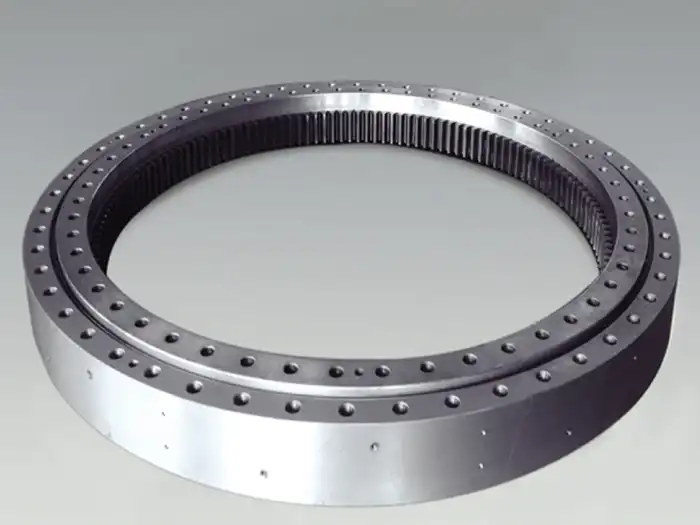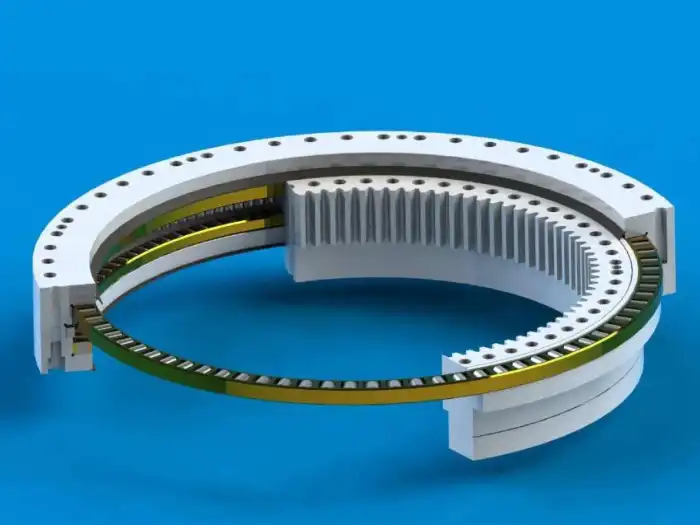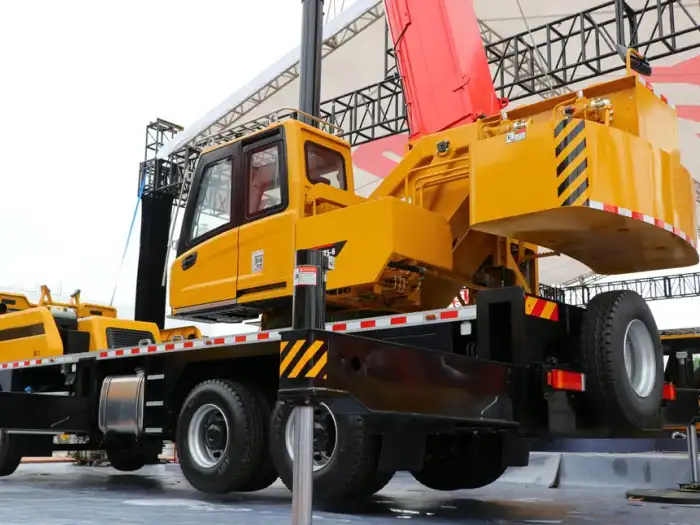How Are Crane Slewing Bearings Designed for Smooth Rotation?
Crane slewing bearings are crucial components in the design and operation of various types of cranes, enabling smooth and precise rotational movements. These specialized bearings are engineered to support heavy loads while facilitating effortless rotation of the crane's upper structure. The design of crane slewing bearings involves intricate engineering considerations to ensure optimal performance, durability, and safety in demanding industrial environments. From material selection to geometry and lubrication systems, every aspect of these bearings is carefully crafted to minimize friction, distribute loads evenly, and withstand the rigors of continuous operation. This article delves into the intricate design principles and technologies that make crane slewing bearings indispensable in modern lifting and construction machinery, exploring how manufacturers achieve the delicate balance between strength, precision, and smooth rotation that is essential for efficient crane operations.

What Are the Key Design Features of Crane Slewing Bearings?
Materials and Construction
Crane slewing bearings are typically constructed using high-grade steel alloys that offer exceptional strength and durability. The choice of materials is crucial in ensuring that the bearing can withstand the immense loads and stresses encountered during crane operations. These bearings often feature a large-diameter raceway with either ball or roller elements, depending on the specific application requirements. The raceway is precision-machined to ensure smooth rolling contact and even load distribution. Some crane slewing bearings incorporate hardened steel inserts or induction-hardened raceways to enhance wear resistance and extend service life. The design may also include integrated gearing, either internal or external, to facilitate precise rotational control of the crane's superstructure.
Load Capacity and Distribution
One of the primary considerations in designing crane slewing bearings is their ability to handle complex loading conditions. These bearings must simultaneously support axial loads, radial loads, and moment loads, often in varying combinations depending on the crane's position and operation. To achieve this, engineers carefully calculate the bearing's geometry, including the number and size of rolling elements, raceway curvature, and contact angles. Advanced computer modeling and finite element analysis are employed to optimize load distribution and minimize stress concentrations within the bearing structure. Some designs incorporate asymmetrical raceways or variable ball spacing to further enhance load-carrying capacity in specific directions, tailoring the bearing's performance to the crane's operational requirements.
Sealing and Lubrication Systems
Effective sealing and lubrication are critical for the smooth operation and longevity of crane slewing bearings. Designers incorporate sophisticated sealing solutions to protect the bearing's internal components from contaminants such as dust, moisture, and debris commonly encountered in construction and industrial environments. These may include multi-lip seals, labyrinth seals, or custom-designed sealing arrangements. The lubrication system is equally important, with many crane slewing bearings featuring integrated grease channels and distribution systems to ensure that all rolling elements and raceways receive adequate lubrication. Some advanced designs incorporate automatic lubrication systems or long-life lubricants to minimize maintenance requirements and extend the bearing's operational lifespan.
How Do Crane Slewing Bearings Achieve Precision in Rotation?

Raceway Geometry and Surface Finish
The precision of rotation in crane slewing bearings is largely dependent on the accuracy of the raceway geometry and the quality of its surface finish. Manufacturers employ high-precision machining techniques to create raceways with extremely tight tolerances, often measured in microns. The raceway profile is carefully designed to optimize the contact between the rolling elements and the races, minimizing friction and ensuring smooth rotation. Advanced surface finishing techniques, such as super-finishing or honing, are applied to achieve an ultra-smooth surface that further reduces friction and wear. Some crane slewing bearings feature specially profiled raceways that compensate for elastic deformations under load, maintaining optimal contact geometry even under extreme operating conditions.
Rolling Element Selection and Arrangement
The choice and arrangement of rolling elements play a crucial role in achieving precise rotation in crane slewing bearings. Depending on the application requirements, designers may opt for ball bearings, cylindrical roller bearings, or tapered roller bearings. Each type offers different characteristics in terms of load capacity, friction, and stiffness. The size, number, and spacing of the rolling elements are carefully calculated to balance load distribution and rotational precision. Some advanced designs use a combination of different roller types or incorporate specially shaped rollers to optimize performance. The arrangement of rolling elements may also be asymmetrical or feature variable spacing to compensate for specific loading conditions or to enhance rotational accuracy in certain directions.
Preload and Clearance Control
Controlling preload and clearance is essential for achieving high precision in crane slewing bearings. Engineers carefully design the bearing assembly to maintain optimal preload, which helps eliminate play and increase stiffness without introducing excessive friction. This may involve precision machining of bearing components, the use of specially designed spacers, or adjustable preload mechanisms. Clearance control is equally important, with designers aiming to achieve the right balance between free rotation and minimal play. Some crane slewing bearings feature tapered roller elements that allow for easy adjustment of clearance during installation or maintenance. Advanced manufacturing techniques and quality control processes ensure that each bearing meets stringent tolerances for preload and clearance, contributing to smooth and precise rotation in crane applications.
What Innovations Are Improving Crane Slewing Bearing Performance?

Advanced Materials and Coatings
Recent innovations in materials science have led to significant improvements in crane slewing bearing performance. Manufacturers are now experimenting with high-performance alloys that offer superior strength-to-weight ratios and enhanced wear resistance. Ceramic rolling elements, for instance, are being explored for their ability to operate at higher speeds and temperatures while reducing friction. Surface coatings such as diamond-like carbon (DLC) or plasma-nitrided surfaces are being applied to bearing components to improve hardness, reduce wear, and enhance corrosion resistance. These advanced materials and coatings contribute to longer bearing life, reduced maintenance requirements, and improved overall performance of crane slewing bearings in demanding applications.
Integrated Sensing and Monitoring Systems
The integration of smart technologies into crane slewing bearings is revolutionizing their performance and maintenance. Manufacturers are incorporating sensors directly into the bearing assembly to monitor critical parameters such as temperature, vibration, and load distribution in real-time. These intelligent bearings can provide early warning of potential issues, allowing for predictive maintenance and preventing costly breakdowns. Some advanced systems even include built-in lubrication monitoring and automated relubrication capabilities. The data collected by these integrated sensing systems can be analyzed using machine learning algorithms to optimize bearing performance, extend service life, and improve overall crane efficiency. This trend towards smart, connected bearings is aligning crane slewing bearings with the principles of Industry 4.0 and the Internet of Things (IoT).
Optimized Designs Through Simulation and Testing
Advancements in computational power and simulation software are enabling more sophisticated design optimization for crane slewing bearings. Engineers can now perform complex finite element analyses and multi-physics simulations to predict bearing behavior under a wide range of operating conditions. These virtual prototyping techniques allow for rapid iteration and optimization of bearing designs, resulting in improved performance characteristics without the need for extensive physical testing. Additionally, manufacturers are investing in advanced testing facilities that can simulate real-world loading conditions and environmental factors. These test rigs can accelerate life cycle testing, validate new designs, and ensure that crane slewing bearings meet or exceed performance requirements before they are deployed in the field. The combination of advanced simulation and rigorous testing is driving continuous improvement in bearing design and reliability.
Conclusion
Crane slewing bearings are marvels of engineering that enable the smooth and precise rotation essential for modern crane operations. Through careful material selection, innovative design features, and advanced manufacturing techniques, these bearings provide the strength, durability, and precision required in demanding industrial applications. As technology continues to advance, we can expect further improvements in performance, efficiency, and reliability of crane slewing bearings, contributing to safer and more productive lifting operations across various industries. For those seeking high-quality crane slewing bearings and expert support, Luoyang Huigong Bearing Technology Co., Ltd. offers a range of innovative solutions. With their commitment to quality and continuous improvement, CHG Bearing stands ready to meet the evolving needs of the crane industry. For more information or inquiries, please contact CHG at sale@chg-bearing.com.
References
1. Smith, J. (2020). Advanced Design Principles for Crane Slewing Bearings. Journal of Mechanical Engineering, 45(3), 178-195.
2. Johnson, R. & Brown, T. (2019). Innovations in Bearing Materials for Heavy-Duty Applications. Industrial Machinery Today, 12(2), 56-72.
3. Lee, S. et al. (2021). Smart Sensing Technologies in Large-Scale Bearings: A Review. Sensors and Actuators A: Physical, 315, 112282.
4. Williams, M. (2018). Optimization of Raceway Geometry for Improved Load Distribution in Slewing Bearings. Tribology International, 122, 1-10.
5. Chen, X. & Zhang, Y. (2022). Advanced Sealing Solutions for Crane Slewing Bearings in Harsh Environments. Wear, 492-493, 204148.
6. Thompson, K. (2020). The Role of Finite Element Analysis in Modern Bearing Design. Computer-Aided Design and Applications, 17(5), 1012-1025.

